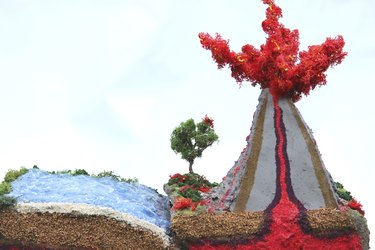Things You'll Need
Acrylic paints in desired water shades
Artist's brush
Paper plate
"Fake water" one-part clear casting resin
Craft sticks
Corrugated cardboard
Plastic wrap

A school project such as a diorama requires a bit of creative rethinking when you're trying to re-create natural elements in miniature form. Water poses one of the trickiest possibilities; while you can create a pond, lake or ocean with construction paper, it just doesn't have the look of true water. Craft resins designed specifically for faux water create a realistic replication of water. You can even sculpt waves and ripples as the material hardens.
Step 1
Paint the underwater area of your project with acrylic paints in the color you want the water to be. To make the water look as though it gets deeper, such as at a beach scene, paint the darkest shade farthest from the shore or beach, adding successively more white to the paint as you get closer to the shoreline. Squirt the paint colors onto a paper plate for easier mixing; just dip your artist's brush into the paints to mix. Allow the paint to dry completely.
Video of the Day
Step 2
Create a shallow, flat water area by brushing the fake water solution over the project area designated for water using an artist's brush. This technique is ideal for a flat project where the water does not need much depth. Add texture such as ripples by gliding the edge of a craft stick over the surface. Skip this step if creating water with slightly more depth over a 3-D landscape.
Step 3
Examine the area designated for water; if it reaches the edge of the project, a wall or dam is required to keep the liquid from spilling over the side. Cover a piece of corrugated cardboard with plastic wrap and press it up against the project edge like a wall, taping it in place and ensuring there are no gaps where the casting liquid may escape.
Step 4
Ensure the project is on a flat surface; otherwise, the fake water may harden on an angle. Pour a shallow layer no deeper than 1/8 inch of the fake-water solution over the area designated for water. Sculpt the top slightly with a craft stick to create ripples or rolling water, if the water is as deep as you'd like and if the project requires rippling water. Allow it to dry for at least 24 hours.
Step 5
Pour an additional layer of fake-water solution over the project if the water requires more depth. Allow 24 hours of drying time between layers. Shape the top layer with a craft stick, if desired, to create rippling water.
Tip
Fake water resins behave much like two-part casting resins, but they do not require any mixing of materials beforehand. Casting resin may be used in place of fake water for a more permanent and durable creation following the mixing directions on the resin package.
Create large waves and whitecaps using a clear, heavy gel medium. Once it dries, paint the tips white with acrylic paint to create a whitecap effect.
Warning
Some resin-style water-casting materials are not designed to work on foam. Read the package carefully to ensure your chosen water product is compatible with your building materials.
Use resin-style water materials only in a well-ventilated area. Wear a dust mask or respirator to avoid breathing in fumes.
Video of the Day